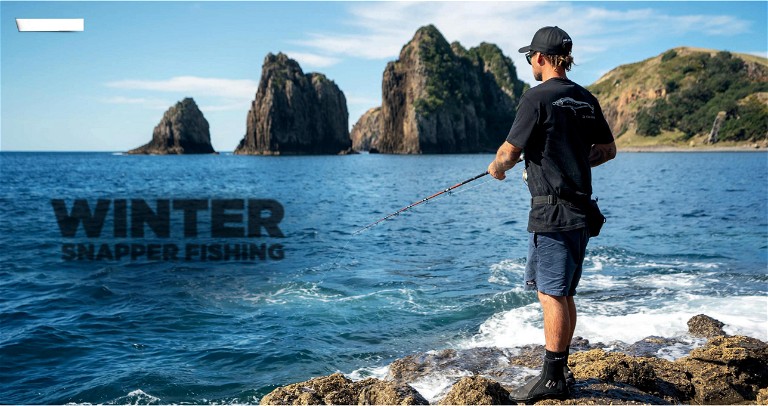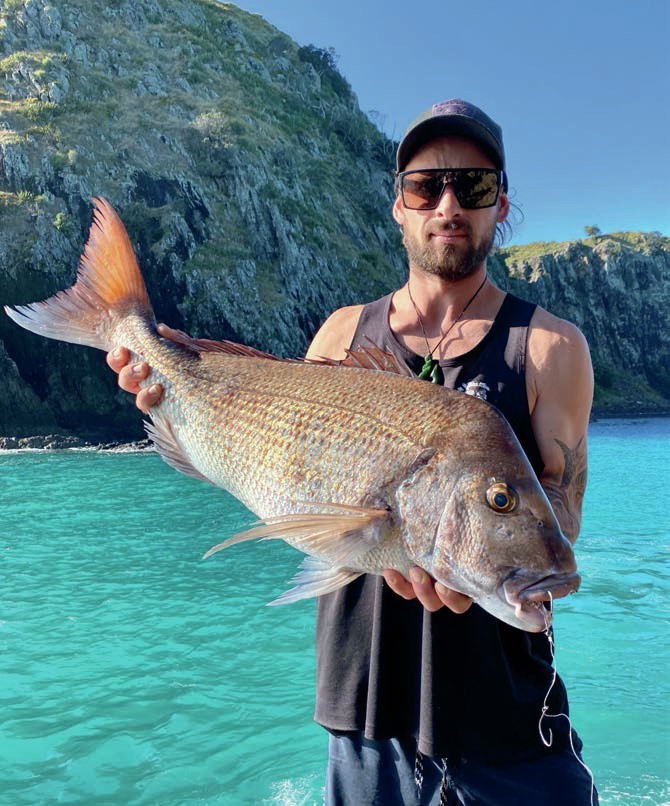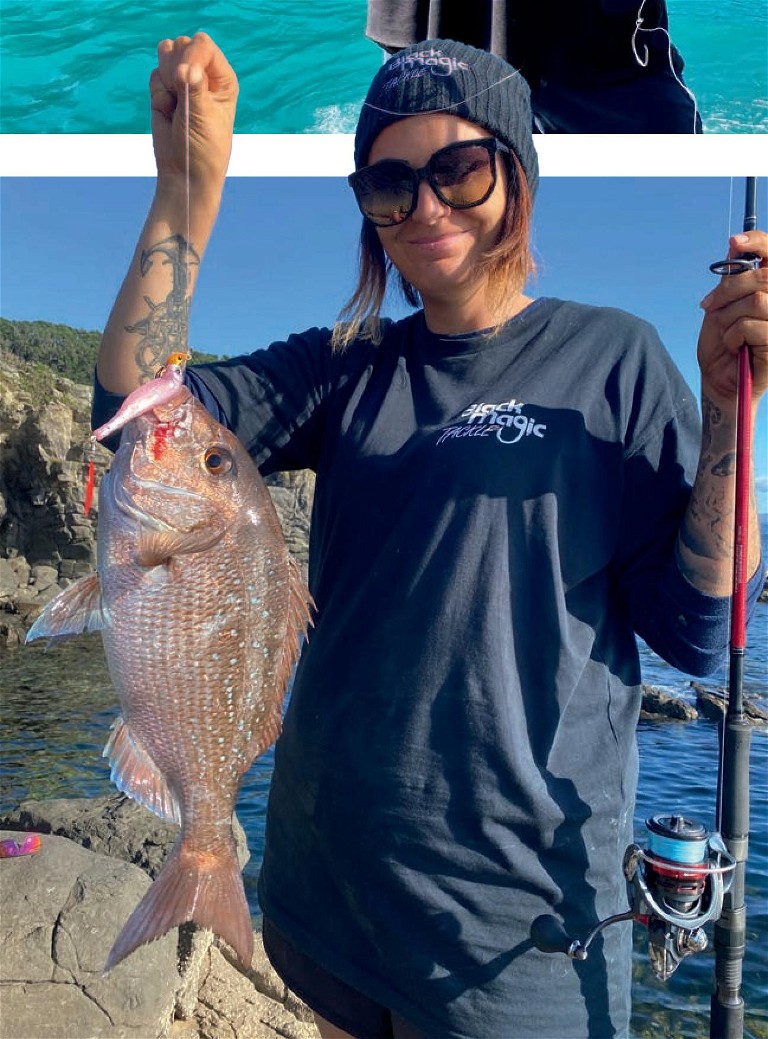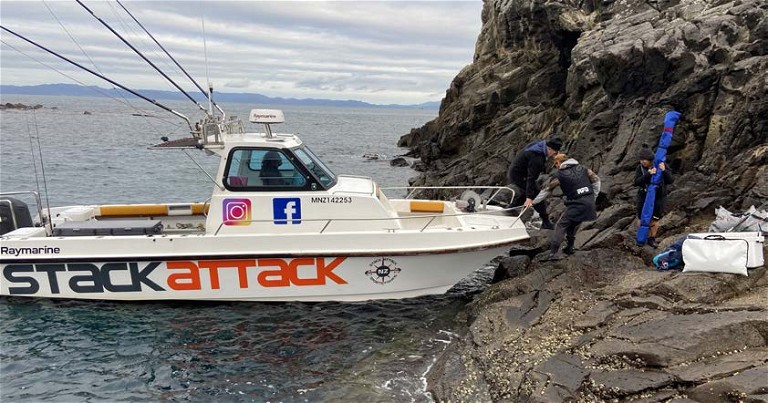WINTER SNAPPER FISHING
Gene and Nicole Bryant from Strictly Land-Based look forward to the three coldest months of the year. While other anglers are packing up rods and storing away boats for the winter, they begin gearing up for the land-based snapper season.

With the cooler temperatures alive and well, it’s no secret many anglers pack away their gear until blue skies and rising temperatures are in sight. For us, however, those three crisp, often wet and wild months are the highlight of our snapper season. Unlike the many fishers that spend the scorching summer days afloat at sea chasing snapper in the warmer waters, we wait for June, July, and August to target large snapper and leave summer for the kingies.
We highly recommend giving snapper fishing a go over the colder months. Whether you’re a novice, a seasoned boatie, or you are simply looking for something to do with the kids, hitting the bricks can be one hell of an adventure. The results speak for themselves!
You don’t need a boat!
Don’t have a boat? It doesn’t matter. Don’t get us wrong – a boat does open the door for offshore adventures, but we would not recommend using one to get to your location before you become familiar with landbased fishing. Nudging into the bricks with your pride and joy can be testing at the best of times; throw a bit of swell in the mix and it may very well put you off attempting it ever again. Loading and unloading mass amounts of gear and your crew also comes with potential hazards. Smooth transitions take time and practice, so start by walking or paddling into your spot with a kayak.
The joys of advanced technology mean it’s not hard to jump on apps such as Google Earth and check out your local coastline for ledges and drop-offs that may be accessible through roadsides, bushlands, or if you’re lucky enough to know the farmer, farmlands. I am forever looking across the room to find Gene scrolling over satellite images of our local coastline. So many of these locations have become hidden gems for us, and because of the rugged cliff tops and sheltered bays on the Coromandel Peninsula, we are lucky to have spots we can walk into regardless of what way the wind is going.
Kayaks can provide access to a variety of locations that are not accessible by boat or foot. It truly is such an amazing feeling paddling into a spot that you can say for certain is untouched. In these areas, you won’t find a piece of trace or broken kina shell in sight; just thriving rock pools full of natural berley waiting to be crushed up to lure in those resident snapper! We always try to leave as early as possible so that we have a good amount of time to scope out our spot for the day without losing precious fishing time.
Both walk-ins and kayaks have their pros and cons, and it just comes down to trial and error, as well as personal preference. Walkins can be tedious, especially if you have a long distance to travel with tens of kilos of berley and bait on your backs! If you are travelling with a few pairs of little legs or you spend your day without getting a bite only to have to walk out in the cold and rain, you may be regretting your decision to not take a vessel.
Kayaks can have their obstacles too. You still need to become familiar with packing, loading and unloading your cargo – ending up in the drink is more common than you think and swell can also limit your accessibility. There have been many times when we have actually towed a spare kayak behind us so that we can distribute weight evenly among the kayaks. This is really important, especially when our kids are passengers.
Launching your kayak from the beach at 6am on a winter’s morning is not the most inviting experience, especially when you are having to walk out to hip depth to get past the breakers. There are gear limitations due to space on kayaks, and paddling to or from your spot against wind can definitely lead to a few harsh words being murmured under your breath!
All this aside, both options are great ways to target snapper over winter, and if you are to ever set foot in a coastal town or local fishing club, you will no doubt come across an old Salty Sea Dog who will share tales of chasing and landing resident snapper – not pannies, but the old, seasoned, battle scar strewn 20+ grandaddy snapper that scour the kelpy ledges and have become accustomed to avoiding the end of your line.
Get prepared
If you’re keen to get out there and target one of these elusive dream fish then make sure you are prepared! We recommend packing the night prior as this typically prevents us forgetting the necessities. It also means that you can take the time to pack smartly and cull extra weight where possible.
Aim to take a variety of baits. Pilchards and bullet tuna are a given, but when possible we take fresh mullet and mackerel, and enjoy using fresh kahawai caught on the day. Kahawai is fantastic if your bait is struggling to make it to the bottom as the skin is tough, meaning smaller fish really have to work for it if they wish to pry it from your hook.
Recently, we have been extremely fond of soft-baiting from the bricks. This is a quick and easy option for those not too keen on lugging bait around. We do recommend still taking berley to encourage and entice the fish to feed. Soft-baiting from a ledge also means that you can try both deep and shallow water drop offs. Do be wary of kelp and bombies as leaving your soft-bait to drop for long periods of time will almost always end in you losing tackle. There are literally hundreds, if not thousands of soft-baits in an array of colours and styles on the market. Personally, our current favourites are the Black Magic Dartspin Pro lures in Glass Minnow & White Ghost. They’re also favourites with the fish and are pre-rigged!
How to pick a spot
Nice ledge? Bit of wash? Plentiful in kina? You’ve found your spot, or have you? In truth, no one can predict the perfect location. Even the most seasoned fisho will have bad days. It’s simply trial and error. We have jumped onto ledges that look like the perfect homes for snapper yet had nothing touch our lines all day. While you can’t automatically know what your chosen location will bring, there are things you can look out for to increase your chances of catching fish that day.


Both bait and lures can get the job done off the rocks.
Snapper are scavengers and tend to sit on the bottom of the ocean, so if you can find a spot loaded with kina then you have found a potential feeding ground. Kina are a snappers favourite treat, so do not be shy about smashing a few up and throwing them in with your berley!
You have most likely heard the term ‘kelpie’. This refers to the darker snapper, as opposed to the fish which have a lighter shade often caused by the sandy floor. Kelpies swim and feed among the weeds, so if your ledge is wrapped in kelp or there are patches of weed in front of you, go for it.
Our favourite places to fish are more often than not ledges that are highly inaccessible. As mentioned, unfished locations are the best! If you are walking into a well-known local spot, chances are your fishing will be a bit better if you push yourself to walk around the bend, or kayak into a piece of coastline that is not able to be accessed by foot or boat.
Patience is key
Be aware that the fishing might not ‘go off’ instantly! As much as we would love every experience to be like the shows you watch on TV, it can take time to attract the fish. One thing Gene’s father Mavis has always said to us is that you should never change your spot that day, but rather let your berley trail attract the snapper to you.
However, if the fish aren’t biting, there are a few things you can try. First among them is mixing up your baits! We have had days where snapper will turn their heads at squid yet we hook up the moment we cast out a headless bullet tuna.
When targeting snapper off the bricks, we absolutely recommend using a bait runner. This means that you’re not striking while the smaller fish are nibbling, instead allowing time for larger snapper to swallow your bait and run before setting the hook. Long slow runs are what we dream of – they are almost cocky, like the fish on the other end knows it’s the boss. If you are lucky enough to come across this experience, just breathe, flick, and then strike. You want to give the fish enough time to swallow your bait as sometimes they will mouth it and drop it if they feel resistance.
Straylining is our preferred method for targeting snapper. A standard setup for us consists of connecting trace to our main line with a double uni knot instead of a swivel, followed by two Black Magic 7/0-8/0 KLT hooks. One of the hooks is left to move freely, while the other is connected with a Uni knot. This allows us to rig up our bait of choice, regardless of its size. We have a saying when it comes to rigging baits: “Don’t be silly, half hitch your Pilly” (and any other bait you rig up!). This encourages the bait to ease its way in a more natural motion to the ocean floor.
It’s winter, so wrap up!
Falling over on the rocks, especially on cold, wet days, is more common than you think, so you need to pack a spare warm pair of pants and a jacket! Because of potential falls, always remember a first aid kit and a dry bag for essentials such as your phone and keys. Proper footwear is a must. Never, ever wear gumboots or jandals on the rocks – you’re asking to slip your way into the drink and full gumboots work like concrete blocks. Invest in footwear with lots of grip which supports your ankles, and a thick enough sole that kina spikes, oyster shells and barnacles can’t penetrate.

Using a boat to access hard to reach spots is effective, but care needs to be taken, particuarly when there’s swell.

Gene with a typically dark kelpy.
To prevent a highly unwanted dip in the sea, always place your kayak and paddle above the water line. The higher you can move it the better, as experience has taught us that rough waves and swell do happen and those paddles, unfortunately, do not work like a boomerang. Gene did not enjoy the one paddle, double kayak trip home – although I didn’t mind it!
All in all, a solid day’s fishing targeting winter snapper can be a hell of a good time. Get prepared, be safe and make the most of the coldest months of the year!

@strictlylandbased